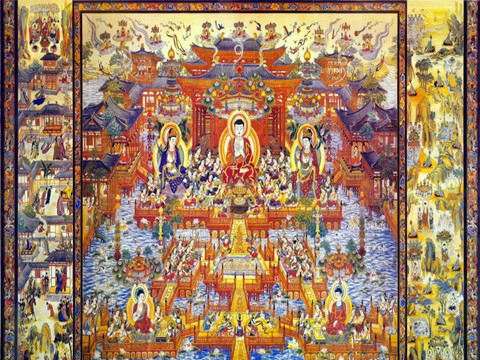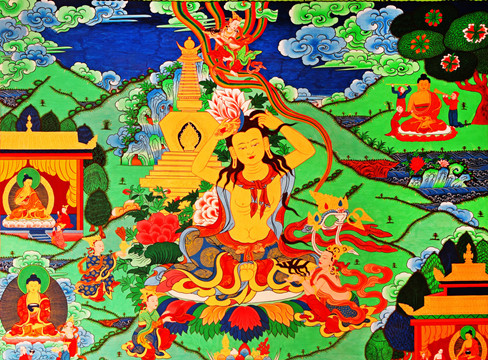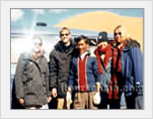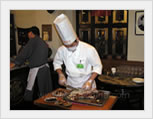
Regong Art Guide
-Travel to Regong ArtOriginating in the Wuhe River Valley ofQinghai Province(TongrenCounty of the Huangnan Tibetan Autonomous Prefecture), Regong art is a successful mix of religious art by Tibetan and Tu ethnic minorities and local folk arts. To better protect the art, it was included in the second phase of the National Folk Culture Protection Project in April 2004.
 Regong art includes paintings (murals and scrolls called "thangka" in Tibetan), clay and wooden sculptures, barbola, color paintings on buildings, patterns,butter sculptures, and so on. Among these, the paintings, sculptures and designs are most famous. The contents of Regong art ranges from the story of the Sakyamuni, Bodhisattvas, Buddhist guardians and fairies, to Buddhist stories. The art -- an important genre in Tibetan Buddhism-- has a history of more than 700 years. It is called " the flower on the Tibetan Plateau" and "a magnifient pearl of Chinese art".
Regong art includes paintings (murals and scrolls called "thangka" in Tibetan), clay and wooden sculptures, barbola, color paintings on buildings, patterns,butter sculptures, and so on. Among these, the paintings, sculptures and designs are most famous. The contents of Regong art ranges from the story of the Sakyamuni, Bodhisattvas, Buddhist guardians and fairies, to Buddhist stories. The art -- an important genre in Tibetan Buddhism-- has a history of more than 700 years. It is called " the flower on the Tibetan Plateau" and "a magnifient pearl of Chinese art".
 Over the past several centuries, Regong art artisans traveled to many different regions to create different works, such as Qinghai Province,Tibetan Autonomous Region,Gansu Province,Sichuan Province,the Inner Mongolian Autonomous Regionand other places in China, as well as India, Nepal, Thailand, Mongolia and other countries in the world, leaving behind numerous exquisite art works. They assimilated artistic nourishment from Tibetan paintings,Dunhuang muralsand foreign similar works and then combined them with local folk arts of Qinghai Province to gradually consummate the techniques of Regong art. The unpretentious painting style, even and harmonious color arrangements and realism of Regong artworks fully reflect Tibetan culture, making the art a curiosity hard to come by in China's cultural heritage.
Over the past several centuries, Regong art artisans traveled to many different regions to create different works, such as Qinghai Province,Tibetan Autonomous Region,Gansu Province,Sichuan Province,the Inner Mongolian Autonomous Regionand other places in China, as well as India, Nepal, Thailand, Mongolia and other countries in the world, leaving behind numerous exquisite art works. They assimilated artistic nourishment from Tibetan paintings,Dunhuang muralsand foreign similar works and then combined them with local folk arts of Qinghai Province to gradually consummate the techniques of Regong art. The unpretentious painting style, even and harmonious color arrangements and realism of Regong artworks fully reflect Tibetan culture, making the art a curiosity hard to come by in China's cultural heritage.
More Attractions in Xining
Your Question & Quick Answer*We welcome and appreciate your questions & reviews
Booking Procedures | Terms & Conditions | Payment Methods | Links | Site Map | About Us | Contact Us | Travel Agent
Copyright 2008, All rights reserved.. itourbeijing.com professional china travel guide and china travel service
TEL: 86-10-85711972 (Universal) 1-888-288-9328 (North America) E-mail: contact@itourbeijng.com
Tours Index | China Tours | Beijing Tours | Xi'an Tours | Shanghai Tours | Guilin Tours | Tibet Tours
China Travel | Beijing Travel | Shanghai Travel | Xi'an Travel | Guilin Travel |Beijing Map
China Golf | Beijing Golf | Shanghai Golf | Xiamen Golf | The Great Wall Travel | Yangtze Cruise | Travel Picture



